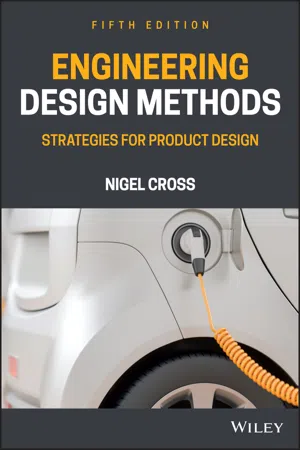
- English
- ePUB (mobile friendly)
- Available on iOS & Android
About this book
A revised text that presents specific design methods within an overall strategy from concept to detail design
The fifth edition of Engineering Design Methods is an improved and updated version of this very successful, classic text on engineering product design. It provides an overview of design activities and processes, detailed descriptions and examples of how to use key design methods, and outlines design project strategies and management techniques. Written by a noted expert on the topic, the new edition contains an enriched variety of examples and case studies, and up to date material on design thinking and the development of design expertise.
This new edition opens with a compelling original case study of a revolutionary new city-car design by ex-Formula One designer Gordon Murray. The study illustrates the complete development of a novel design and brings to life the process of design, from concept through to prototype. The core of the book presents detailed instructions and examples for using design methods throughout the design process, ranging from identifying new product opportunities, through establishing functions and setting requirements, to generating, evaluating and improving alternative designs. This important book:
- Offers a revised and updated edition of an established, successful text on understanding the design process and using design methods
- Includes new material on design thinking and design ability and new examples of the use of design methods
- Presents clear, detailed and illustrated presentations of eight key design methods in engineering product design
Written for undergraduates and postgraduates across all fields of engineering and product design, the fifth edition of Engineering Design Methods offers an updated, substantial, and reliable text on product design and innovation.
Frequently asked questions
- Essential is ideal for learners and professionals who enjoy exploring a wide range of subjects. Access the Essential Library with 800,000+ trusted titles and best-sellers across business, personal growth, and the humanities. Includes unlimited reading time and Standard Read Aloud voice.
- Complete: Perfect for advanced learners and researchers needing full, unrestricted access. Unlock 1.4M+ books across hundreds of subjects, including academic and specialized titles. The Complete Plan also includes advanced features like Premium Read Aloud and Research Assistant.
Please note we cannot support devices running on iOS 13 and Android 7 or earlier. Learn more about using the app.
Information
Part One
Design Fundamentals
1
The Activity of Design
What Designers Say
I believe in intuition. I think that's the difference between a designer and an engineer… I make a distinction between engineers and engineering designers… An engineering designer is just as creative as any other sort of designer.
A lot of engineering design is intuitive, based on subjective thinking. But an engineer is unhappy doing this. An engineer wants to test; test and measure. He's been brought up this way and he's unhappy if he can't prove something. Whereas an industrial designer… is entirely happy making judgements that are intuitive.
As a matter of fact, the solution that I came up with wasn't a solution to the problem at all. I never saw it as that… But when the chair was actually put together (it) in a way quite well solved the problem, but from a completely different angle, a completely different point of view.
To start with you see the thing in your mind and it doesn't exist on paper and then you start making simple sketches and organising things and then you start doing layer after layer… it is very much a dialogue.
What Designers Do
Communication of designs
Table of contents
- Cover
- Table of Contents
- Title Page
- Copyright
- Introduction
- Part One: Design Fundamentals
- Part Two: Design Practice
- Part Three: Design Thinking
- References and Sources
- Index
- End User License Agreement